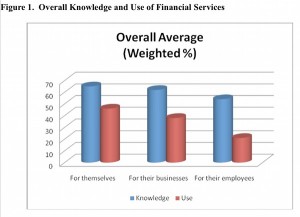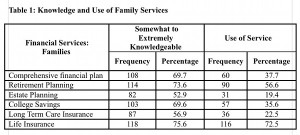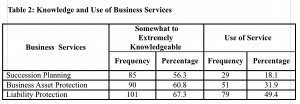Hispanic business owners are more knowledgeable about financial planning than previous research suggests
Posted by Elena del Valle on October 11, 2010
By Dianna L. Stone, Ph.D., professor of Management
Joy Row, MBA, research project manager
Teresa Svacina, M.S., and Julio Canedo-Soto, MBA doctoral students
University of Texas at San Antonio




Dianna L. Stone, Ph.D., Joy Row, MBA, Teresa Svacina, M.S. and Julio Canedo-Soto, MBA
There has been a dramatic rise in the number of Hispanic owned businesses in the U. S. One reason for this is that entrepreneurship often provides a springboard for the economic advancement and social integration of minorities. Despite this growth, little research has focused on the success of Hispanic owned businesses. Studies have shown that minorities are more likely to start small businesses, but are less likely to be successful than Anglos1.
Although there may be a number of reasons for this, researchers have argued that the lack financial skills may be a key source of the problem. Results of other research shows that Hispanics2, and Hispanic business owners3 may have limited knowledge of financial planning. Thus, the primary purpose of this article is to relay results of some recent research on Hispanic business owners’ knowledge and use of financial planning.
Method
Researchers at the University of Texas at San Antonio surveyed 171 Hispanic business owners’ in South Central Texas between March and June, 2010. The survey was administered in either English or Spanish using online or paper formats. Participants were recruited through emails, meetings of professional organizations, and direct contact. The sample consisted of 92 men, 65 women. Their average age was 43.5 years, and 62% had undergraduate or graduate degrees. On average, they were in business 8.7 years, and had 13 employees. Their businesses were in a variety of industries including construction, retail, personal care, and restaurant.
Results for Knowledge and Use of Financial Services
The results were inconsistent with previous research that showed Hispanics have limited knowledge of financial planning. Our findings revealed that a substantial number of Hispanic business owners were somewhat to extremely knowledgeable about financial planning for themselves and their families (65%), their businesses (62%), and their employees (54%).
However, the results also indicated that there was a discrepancy between knowledge and use of financial planning. Even though respondents had knowledge of financial services, 46% reported using them for their families, 38% for their businesses, and 21% for their employees. Figure 1 displays the differences between overall knowledge and use of financial services.
Figure 1. Overall Knowledge and Use of Financial Services
Results for Types of Financial Services
The results also revealed that the knowledge and use varied with the type of financial service. Tables 1 and 2 present the differences in knowledge and use for family and businesses services.
Table 1 indicates that respondents were knowledgeable about most financial services for their families. In addition, 56.6% were likely to use retirement planning, and 72.5% used life insurance. However, the usage rates for other types of financial services were lower than the reported knowledge levels.
Table 1: Knowledge and Use of Family Services
Table 2 shows that respondents had considerable knowledge of succession planning, business asset protection, and liability protection. However, approximately 49% reported using liability protection, but relatively few respondents used succession planning and business asset protection.
Table 2: Knowledge and Use of Business Services
Discussion
Our results challenge previous research that argued Hispanics have limited knowledge of financial planning. They also have important implications for training and marketing financial services. First, they imply that a substantial number of Hispanic business owners have knowledge of financial services, but others may still training to enhance their knowledge levels.
Second, the data suggest that even though Hispanic business owners have knowledge of financial services, their usage rates may be lower than their knowledge levels. Thus, marketing efforts might be aimed at those services with low usage rates. Although there may be a number of reasons that business owners are not using some types of services, there was a statistically significant correlation (r – .39) between revenue levels and usage rates. Thus, low revenue levels may be one reason they are not using financial services. Therefore, financial advisers may want to encourage those with low revenue levels to make small investments because these types of investments pay off over time.
References
1Sullivan, D. (2007). Minority entrepreneurs: More likely to try, but less likely to succeed? The Academy of Management Perspectives, 78-79.
2Avalos, A. & Peterson, J. (2009). Assessing financial literacy among Hispanics in the California Central Valley. Fresno: California State University at Fresno.
3Mass Mutual. (2009). The state of Houston Hispanic Business Owners’ fiscal fitness. Springfield, MA: Mass Mutual.
Dianna L. Stone is the associate editor of the Business Journal of Hispanic Research. Along with her co-authors she redesigned the survey, conducted a literature review, collected data, analyzed data, and wrote the research summary. Joy Row has managed the research project and collected, entered,and analyzed the data. She also interfaced with small business owners, and wrote part of the research summary. Teresa Svacina helped redesign the survey, conducted the literature review, set up the online survey system, collected data, analyzed data, and wrote part of the research summary. Julio Canedo-Soto is from Monterrey, Mexico where he served in Human Resources and Student Advising at Monterrey Tech. He translated the survey into Spanish, and collected and analyzed the data. He also wrote part of the research summary.













I enjoyed reading your article and found it to be informative and to the point. Thank you for not rambling on and on just to fill the page.